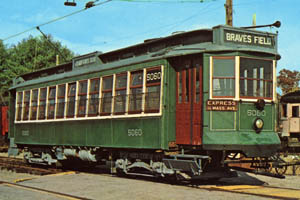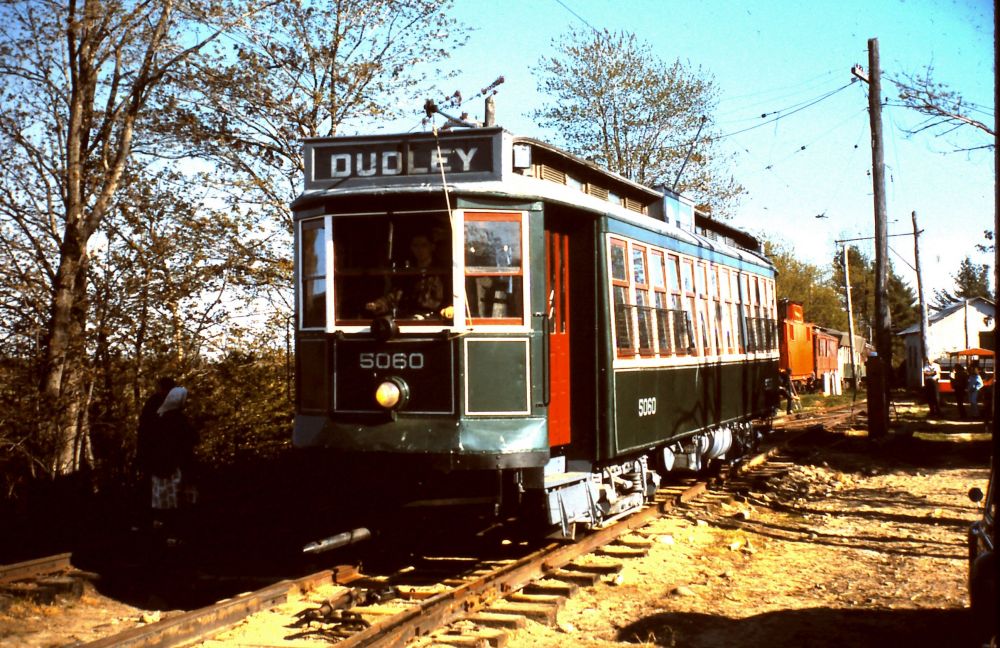
- Builder
- J. G. Brill Co.
- Description
- Semi-convertible, Boston 'Type 2'
- Secondary Use
- Railway maintenance
- Type
- City and Suburban Streetcars
- Year
- 1906
- Retired from Service
- 1954
- Acquired by the Museum
- 1954
- Note
- As of September 2016, No. 5060 is stored in Fairview carbarn. None of Seashore’s three “Type 2s” are operable.
Boston Elevated Ry. 5060
From Boston, Massachusetts
History
The opening of the East Boston Tunnel in 1905 changed the character of East Boston from a maritime center to a streetcar suburb, by reducing the travel time from Maverick Square in East Boston to Downtown Boston from almost a half hour to less than 5 minutes. The Boston Elevated designed a large car for the line, based on its elevated cars, built a prototype and tested it. In the meantime, it assigned its newest double truck cars to the line, the 26-1/2 foot group, and quickly replaced them with larger cars off-the-shelf from Brill (the “Type 1”). In 1906, the Elevated ordered 50 new “Type 2” cars from Brill (Nos. 5041 – 5090), 32 of which were specially fireproofed for use in the tunnel. No. 5060 is one of these “tunnel cars.” These “Type 2s” were 45 feet long overall, with sliding “easy access” doors, two motors and automatic air brakes similar to those used in elevated cars. The BERy ran the “Type 2s” in multiple unit, rapid transit-style operation. Continued East Boston Tunnel ridership increases caused the BERy to replace the “Type 2s” with 3 car center-entrance trains in 1917 and full scale rapid transit in 1924. The BERy moved the “Type 2s” to various surface streetcar lines. The BERy replaced the sliding doors with folding doors.
The Type 2s did not last long after being displaced from East Boston, as they were heavy and underpowered compared to more modern cars. In 1928, the BERy installed large air compressors and large tanks inside No. 5060 for use supporting major trackwork around the system. BERy did similar conversions on Nos. 5055 and 5071 in 1926 and 1927. One of these, No. 5060, was released from service in 1954, and moved to Seashore. Nos. 5055 and 5071 were used sporadically afterward. No. 5055 remained in maintenance service after the Metropolitan Transit Authority acquired ownership in 1947.
Seashore acquired No. 5060 in 1954. In 1973, Seashore acquired Nos. 5055 and 5071. No. 5060 has seen extensive restoration work. Seashore removed the compressor and other machinery from the interior and restored the exterior to its original passenger car appearance. For further restoration, Seashore needs to install seats and folding steps. No. 5060 has been dormant many years. Nos. 5055 and 5071 remain as compressor cars. One feature unique to these cars are the drawbars, which are tubular instead of rectangular, making towing awkward. Having more than one “Type 2” car gives Seashore the potential of running the cars in their historic, multiple unit operation.
Technical Information
- Seats: 52
- Control: M (C-26C)
- Brakes: AMT
- Compressor: D2-EG
Trucks
- Number: 2
- Manufacturer: Brill
- Model: 27E2/27BE2
Motor
- Number: 2
- Manufacturer: Westinghouse
- Model: 306CVD4
Weight and Dimensions
- Length: 46’ 6.00"
- Width: 8’ 2.00"
- Height: 12’
- Weight: 56536 lbs.
Additional Images

Russell Monroe in 1965
© 1998 - 2025 New England Electric Railway Historical Society. All Rights Reserved.